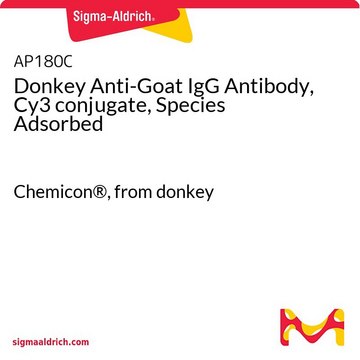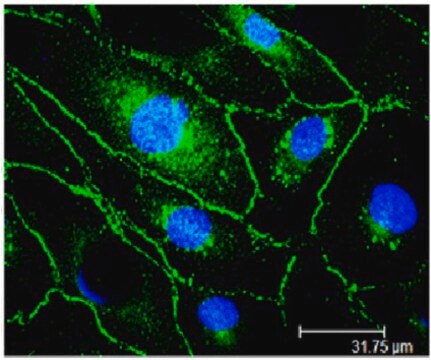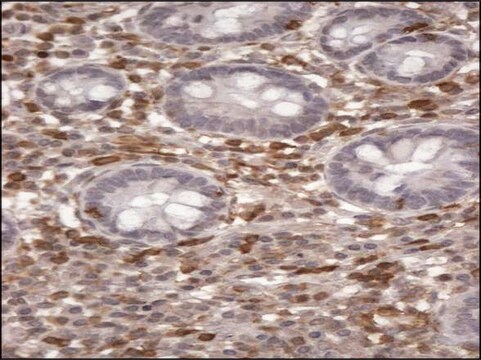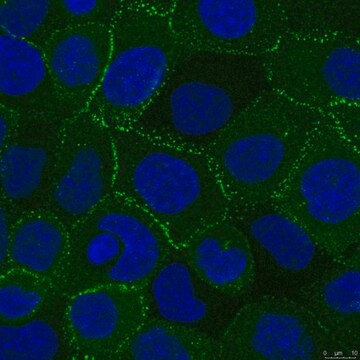AP180R
Donkey Anti-Goat IgG Antibody, Rhodamine conjugate, Species Adsorbed
Chemicon®, from donkey
Sign Into View Organizational & Contract Pricing
All Photos(1)
About This Item
UNSPSC Code:
12352203
eCl@ss:
32160702
NACRES:
NA.46
Recommended Products
biological source
donkey
Quality Level
conjugate
TRITC conjugate
rhodamine conjugate
antibody form
affinity purified immunoglobulin
antibody product type
secondary antibodies
clone
polyclonal
species reactivity
goat
manufacturer/tradename
Chemicon®
technique(s)
immunofluorescence: suitable
shipped in
wet ice
target post-translational modification
unmodified
Specificity
Goat IgG
WAVELENGTH:
Absorption peak = 550 nm, Emission peak = 570 nm.
WAVELENGTH:
Absorption peak = 550 nm, Emission peak = 570 nm.
Application
Donkey anti-Goat IgG Antibody, Rhodamine conjugate, Species Adsorbed is an antibody against Donkey Goat IgG for use in IF.
Research Category
Secondary & Control Antibodies
Secondary & Control Antibodies
Research Sub Category
Secondary Antibodies Adsorbed for Dual Labeling
Secondary Antibodies Adsorbed for Dual Labeling
Suggested dilution for most applications: 1:50-1:200 Optimal working dilutions must be determined by end user.
Physical form
Lyophilized. Buffer = 0.02 M Sodium Phosphate, 0.25 M NaCl, pH 7.6 with 15 mg/mL BSA, and 0.1% sodium azide.
RECONSTITUTION:
Reconstitute with 500 μL of sterile distilled water.
RHODAMINE/PROTEIN:
Approximately 0.5 (A550/A280).
RECONSTITUTION:
Reconstitute with 500 μL of sterile distilled water.
RHODAMINE/PROTEIN:
Approximately 0.5 (A550/A280).
Storage and Stability
Maintain lyophilized product at 2-8°C for up to 12 months. After reconstitution the product is stable for several weeks at 2-8°C as an undiluted liquid. For extended storage after reconstitution, add an equal volume of glycerol to make a final concentration of 50% glycerol followed by storage at -20°C in undiluted aliquots for up to 12 months. Please note the concentration of protein (and buffer salts) will decrease to one-half of the original after the addition of glycerol. Avoid repeated freeze/thaw cycles.
Legal Information
CHEMICON is a registered trademark of Merck KGaA, Darmstadt, Germany
Disclaimer
Unless otherwise stated in our catalog or other company documentation accompanying the product(s), our products are intended for research use only and are not to be used for any other purpose, which includes but is not limited to, unauthorized commercial uses, in vitro diagnostic uses, ex vivo or in vivo therapeutic uses or any type of consumption or application to humans or animals.
Not finding the right product?
Try our Product Selector Tool.
hcodes
pcodes
Hazard Classifications
Aquatic Chronic 3
Storage Class
11 - Combustible Solids
wgk_germany
WGK 3
Certificates of Analysis (COA)
Search for Certificates of Analysis (COA) by entering the products Lot/Batch Number. Lot and Batch Numbers can be found on a product’s label following the words ‘Lot’ or ‘Batch’.
Already Own This Product?
Find documentation for the products that you have recently purchased in the Document Library.
A novel mutation in the GATA4 gene in patients with Tetralogy of Fallot.
Georges Nemer, Fatimah Fadlalah, Julnar Usta, Mona Nemer, Ghassan Dbaibo, Mounir Obeid, Fadi Bitar
Human Mutation null
CXCL14-like immunoreactivity in growth hormone-containing cells of urodele pituitaries.
Hirohumi Suzuki,Mondo Itoh,Toshiharu Yamamoto
Regulatory Peptides null
H Suzuki et al.
Anatomia, histologia, embryologia, 47(2), 159-166 (2018-01-10)
Immunohistochemical techniques were employed to investigate the distribution of amylin-like immunoreactive cells in the pancreas of gecko Homopholis fasciata. Four types of endocrine cells were distinguished: insulin immunoreactive (B cells), pancreatic polypeptide immunoreactive (PP cells), glucagon and pancreatic polypeptide immunoreactive
An appraisal of intermediate filament expression in adult and developing pancreas: vimentin is expressed in alpha cells of rat and mouse embryos.
Di Bella, A; Regoli, M; Nicoletti, C; Ermini, L; Fonzi, L; Bertelli, E
The journal of histochemistry and cytochemistry : official journal of the Histochemistry Society null
Annalisa Altera et al.
Graefe's archive for clinical and experimental ophthalmology = Albrecht von Graefes Archiv fur klinische und experimentelle Ophthalmologie, 259(9), 2559-2571 (2021-03-25)
To study the composition of the internal limiting membrane (ILM) of the retina, the extracellular matrix (ECM) of idiopathic epiretinal membranes (iERMs), and the relationships occurring between the two membranes. Forty-six iERMs, 24 of them associated with the ILM, were
Our team of scientists has experience in all areas of research including Life Science, Material Science, Chemical Synthesis, Chromatography, Analytical and many others.
Contact Technical Service








